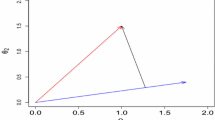Abstract
It is often considered desirable to have the same ordering of the items by difficulty across different levels of the trait or ability. Such an ordering is an invariant item ordering (IIO). An IIO facilitates the interpretation of test results. For dichotomously scored items, earlier research surveyed the theory and methods of an invariant ordering in a nonparametric IRT context. Here the focus is on polytomously scored items, and both nonparametric and parametric IRT models are considered.
The absence of the IIO property in twononparametric polytomous IRT models is discussed, and two nonparametric models are discussed that imply an IIO. A method is proposed that can be used to investigate whether empirical data imply an IIO. Furthermore, only twoparametric polytomous IRT models are found to imply an IIO. These are the rating scale model (Andrich, 1978) and a restricted rating scale version of the graded response model (Muraki, 1990). Well-known models, such as the partial credit model (Masters, 1982) and the graded response model (Samejima, 1969), do no imply an IIO.
Similar content being viewed by others
References
Andrich, D. (1978). A rating scale formulation for ordered response categories.Psychometrika, 43, 561–573.
Andrich, D. (1995). Distinctive and incompatible properties of two common classes of IRT models for graded responses.Applied Psychological Measurement, 19, 101–119.
Cavalini, P. M. (1992).It's an ill wind that brings no good. Studies on odour annoyance and the dispersion of odorant concentrations from industries. Unpublished doctoral dissertation, University of Groningen, The Netherlands.
Chang, H., & Mazzeo, J. (1994). The unique correspondence of the item response function and item category response functions in polytomously scored item response models.Psychometrika, 59, 391–404.
Hemker, B. T. (1996).Unidimensional IRT models for polytomous items, with results for Mokken scale analysis. Unpublished doctoral dissertation, Utrecht University, The Netherlands.
Hemker, B. T., Sijtsma, K., & Molenaar, I. W. (1995). Selection of unidimensional scales from a multidimensional item bank in the polytomous Mokken IRT model.Applied Psychological Measurement, 19, 337–352.
Hemker, B. T., Sijtsma, K., Molenaar, I. W., & Junker, B. W. (1996). Polytomous IRT models and monotone likelihood ratio of the total score.Psychometrika, 61, 679–693.
Hemker, B. T., Sijtsma, K., Molenaar, I. W., & Junker, B. W. (1997). Stochastic ordering using the latent trait and the sum score in polytomous IRT models.Psychometrika, 62, 331–347.
Holland, P. W., & Rosenbaum, P. R. (1986). Conditional association and unidimensionality in monotone latent variable models.The Annals of Statistics, 14, 1523–1543.
Junker, B. W. (1991). Essential independence and likelihood-based ability estimation for polytomous items.Psychometrika, 56, 255–278.
Masters, G. N. (1982). A Rasch model for partial credit scoring.Psychometrika, 47, 149–174.
Mellenbergh, G. J. (1995). Conceptual notes on models for discrete polytomous item responses.Applied Psychological Measurement, 19, 91–100.
Molenaar, W. (1970).Approximations to the Poisson, binomial, and hypergeometric distribution functions. Amsterdam: Mathematical Centre Tracts 31.
Molenaar, I. W. (1997). Nonparametric models for polytomous responses. In W. J. van der Linden & R. K. Hambleton (Eds.),Handbook of modern item response theory (pp. 369–380). New York: Springer.
Molenaar, I. W., Debets, P., Sijtsma, K., & Hemker, B. T. (1994).User's manual MSP. Groningen, The Netherlands: iecProGAMMA.
Muraki, E. (1990). Fitting a polytomous item response model to Likert-type data.Applied Psychological Measurement, 14, 59–71.
Muraki, E. (1992). A generalized partial credit model: application of an EM algorithm.Applied Psychological Measurement, 16, 159–176.
Rosenbaum, P. R. (1987a). Probability inequalities for latent scales.British Journal of Mathematical and Statistical Psychology, 40, 157–168.
Rosenbaum, P. R. (1987b). Comparing item characteristic curves.Psychometrika, 52, 217–233.
Samejima, F. (1969). Estimation of latent trait ability using a response pattern of graded scores.Psychometrika Monograph, No. 17.
Scheiblechner, H. (1995). Isotonic ordinal probabilistic models (ISOP).Psychometrika, 60, 281–304.
Sijtsma, K., Debets, P., & Molenaar, I. W. (1990). Mokken scale analysis for polychotomous items: theory, a computer program and an empirical application.Quality & Quantity, 24, 173–188.
Sijtsma, K., & Junker, B. W. (1996). A survey of theory and methods of invariant item ordering.British Journal of Mathematical and Statistical Psychology, 49, 79–105.
Thissen, D., & Steinberg, L. (1986). A taxonomy of item response models.Psychometrika, 51, 567–577.
Verhelst, N. D., & Glas, C. A. W. (1995). The one parameter logistic model. In G. H. Fischer & I. W. Molenaar (Eds.),Rasch models. Foundations, recent developments, and applications (pp. 215–237). New York: Springer.
Author information
Authors and Affiliations
Corresponding author
Rights and permissions
About this article
Cite this article
Sijtsma, K., Hemker, B.T. Nonparametric polytomous IRT models for invariant item ordering, with results for parametric models. Psychometrika 63, 183–200 (1998). https://doi.org/10.1007/BF02294774
Received:
Revised:
Issue Date:
DOI: https://doi.org/10.1007/BF02294774




